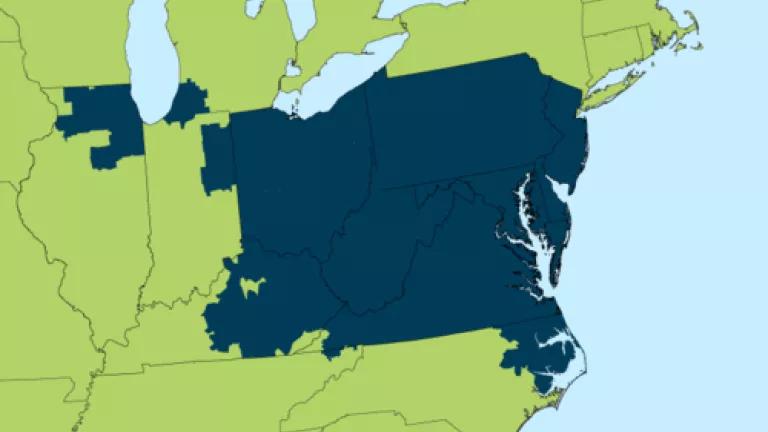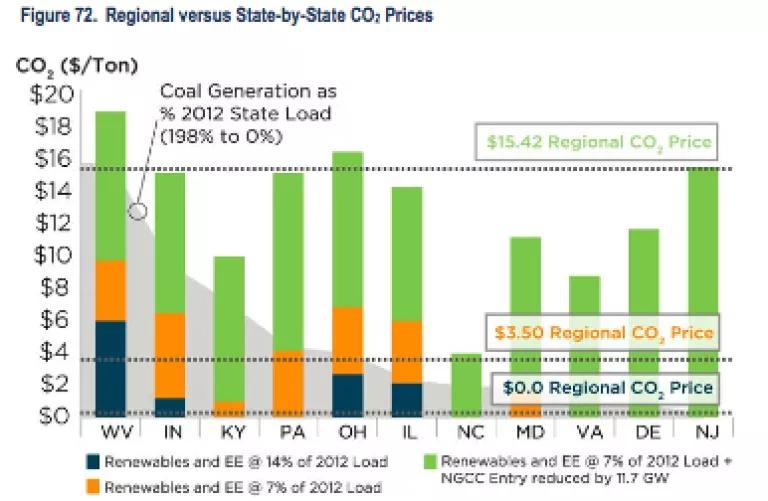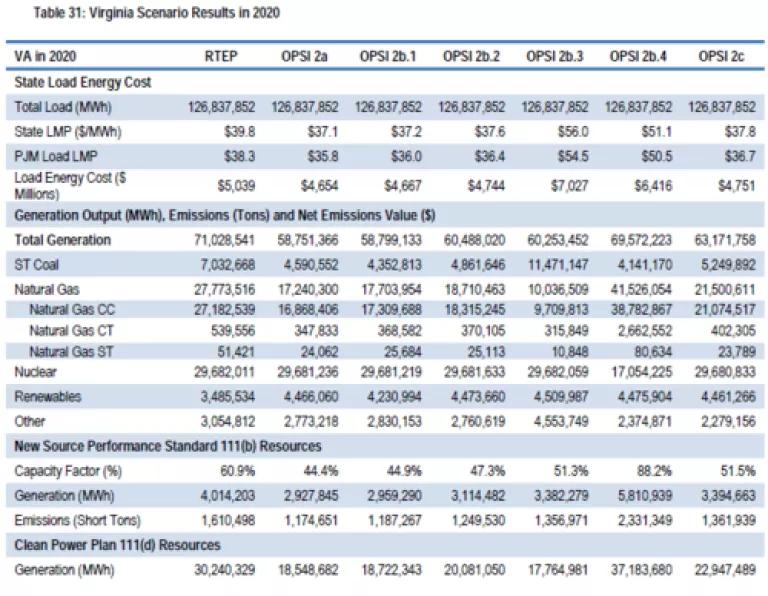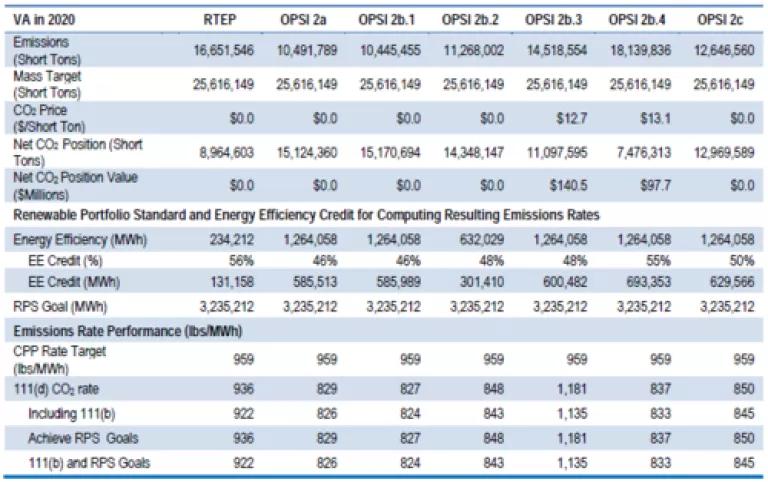
An analysis last week confirms that Governor McAuliffe can be an economic and regional leader by pursuing a regional multi-state approach to address climate change through the EPA's Clean Power Plan. The "CPP" is America's first national effort to tackle the largest source of the pollution driving climate change: carbon dioxide emissions from fossil-fueled power plants. By shifting to cleaner sources and more energy efficient use of electricity through a regional approach, the Governor can stem the climate havoc that imperils Virginia's coast, economy, and public health.
In its recently-released analysis, PJM -- the operator of the world's largest electricity market in the world which includes Virginia -- concludes that Virginia can generate net revenue from the CPP as early as 2020 through a market-based allowance trading program among PJM states. In such a regional plan, Virginia efficiently reduces its carbon pollution and then sells pollution "allowances" to neighboring states that have more pollution to reduce, generating revenue for the Commonwelth in the process. PJM shows that this is the cheapest pathway for all states than if they decided to go it alone.
The map above shows the PJM states to whom Virginia could sell its lowest-cost pollution reductions. Source: PJM.
A great example of the smashing economic success of a market-based, regional approach to reducing pollution is George H.W. Bush's acid rain program, which Bush called one of his proudest achievements. PJM's authoritative analysis shows that Governor McAuliffe can also meet his goal of addressing climate change, while simultaneously strengthening Virginia's economy, increasing its competitiveness with other states, and reducing its energy costs.
Specifically, PJM's report (eloquently summarized here by my colleague Starla Yeh) shows that if Governor McAuliffe writes his state plan utilizing a regional PJM market-based approach, Virginia has the second-easiest target to reach among the 11 PJM states analyzed. Therefore, PJM finds, Virginia would see lower energy costs under the Clean Power Plan, and moreover can generate revenue through regional trading starting in 2020.

Above, Virginia has the second lowest CO2 price in PJM states. Source: PJM.
That's all great news for Job-Creator-in-Chief Governor McAuliffe, as was underscored in the Washington Post by a former chairman of the Federal Energy Regulatory Commission, who also declared that "clean energy will be cheaper for Virginians."
Below is an overview of the good economic news for Governor McAuliffe, as he rolls up his sleeves to write a state plan that will maximize CPP job creation.
Energy prices in Virginia will decrease under the Clean Power Plan:
Utilizing a regional market-based plan, energy prices would fall in Virginia under the CPP (compared to business-as-usual absent the CPP), if Virginia achieves its modest renewable energy goal and taps into its virtually untouched energy efficiency resources. This aligns with similarly robust analysis that shows lower energy bills for Virginians under the CPP.

The above chart shows Virginia's energy costs to be higher under non-Clean Power Plan business-as-usual ("Load Energy Cost" in the "RTEP" column) than under the Clean Power Plan. Source: PJM.
Virginia is already effortlessly coasting toward compliance with the Clean Power Plan:
PJM's analysis confirms previous findings that - if current trends continue - Virginia will be 80% of the way to its pollution reduction goal in 2020. This is mainly due to the already-underway phaseout of the state's oldest and dirtiest coal plants and an increased use of lower-polluting resources. And, by 2030, thanks to an EPA formula that favors Virginia's particular energy mix (more on that below), Virginia is on track to overcomply with the Clean Power Plan, again under a business-as-usual, don't-do-a-thing approach.

The above chart shows Virginia achieving a full 80% of its required "CPP Rate Target" in 2020 ("111(d) CO2 rate") under do-nothing, business-as-usual conditions ("RTEP"). Source: PJM.
The only question, then, is whether or not Governor McAuliffe creates jobs and generates revenue as well: if Virginia rests on its laurels, it will cede leadership and jobs in the clean energy sector to its more economically advanced and competitive neighbors. Virginia would also miss out on the chance to generate revenue by selling its easily-achievable carbon reductions to PJM states that have more pollution to reduce.
Virginia's existing lower-carbon power fleet is rewarded by the Clean Power Plan:
Some have mistakenly claimed that the Clean Power Plan is somehow "unfair" to Virginia. PJM's analysis confirms the exact opposite: Virginia has already balanced its high-carbon coal with lower-carbon gas and nuclear plants, so each addition of zero-carbon renewables and energy efficiency hits a smaller pool of carbon and is thus more effective at displacing more of the pollutant. Compare that to our neighboring state of West Virginia, which PJM concluded would have the highest carbon price of all the PJM states, due to a reliance on coal that is triple Virginia's. As a result, in addition to making smart investments in energy efficiency and renewable energy, the next-cheapest compliance option for West Virginia could be to purchase allowances from Virginia or other neighbors - generating additional revenue for the Commonwealth while the Mountain State achieves compliance more cheaply! Because Virginia's cleaner fleet is rewarded in this way by the Clean Power Plan (as currently proposed), Governor McAuliffe should be gunning for aggressive clean energy gains in his state plan for the CPP: right out of the gate in 2020, Virginia could sell the carbon reductions across state lines.
Reports of the death of coal plants under the Clean Power Plan have been greatly exaggerated:
Grid operator PJM, whose very reason for existence is to assess what power plants and transmission lines need to be online and when, has determined that any coal unit retirements under the CPP will likely be a "gradual" process across 2020-2030. So one of the best ways to keep coal units online, ironically, is to double down on renewables and energy efficiency. Here's why: the addition of clean energy into the state's energy mix reduces the burden on coal plants to do the carbon cleanup themselves, by displacing their carbon-intensity with zero-emissions clean energy.
PJM's finding of a strengthened Virginia economy under the CPP confirms what Virginians already know:
PJM's prediction of economic prosperity for Virginia under the Clean Power Plan affirms Virginians' overwhelming belief that clean energy will result in a stronger Virginia economy, as revealed in recent bipartisan polls.
PJM's prediction of profitable renewable energy and energy efficiency in Virginia affirms the recent work of the General Assembly.
The Virginia legislature smartly passed legislation this year to increase energy efficiency deployment and to boost renewable energy by 2020. Not only will those additions help Virginia over-comply with the CPP in that year, as described above, if the state achieves its statutory renewables target and just 50% of EPA's modest (and optional) energy efficiency projection, those carbon pollution reductions can generate net-gain revenue as part of a regional market.
The business opportunity of the Clean Power Plan is good news for Governor McAuliffe. PJM's analysis is an economic silver platter for Governor McAuliffe, as it shows that a multi-state approach to the Clean Power Plan is his best chance to achieve two of his priorities at once: sparking a new Virginia economy and tackling climate change. Not only do renewable energy and energy efficiency now stand on their own as cost-effective additions to the energy supply, the Governor's own Energy Plan already smartly prioritizes the very same energy that will turn a profit under PJM's analysis.
There is no time like the present for Governor McAuliffe to lead.
Governor McAuliffe's leadership on climate and energy, as well as Virginia's strong position under the CPP, make him the natural leader to engage his fellow PJM states to discuss what is clearly his (and their) best option for Clean Power Plan compliance: a regional, mass-based allowance trading program that will lower costs for consumers in the region, while raising revenues to be reinvested in clean energy for the ecomic and environmental benefit of folks right here in Virginia.
If anyone's a dealmaker, it's him!
